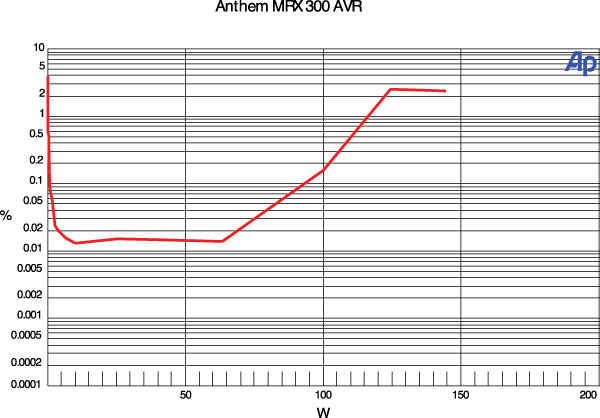You state that the MRX 300 has 4 in/2 outputs for HDMI; yet the photo of the back only shows ONE HDMI output. Is this an early photo of a pre-production model or an error?
Anthem MRX 300 A/V Receiver HT Labs Measures
Five channels driven continuously into 8-ohm loads:
0.1% distortion at 71.4 watts
1% distortion at 83.4 watts
Seven channels driven continuously into 8-ohm loads:
0.1% distortion at 56.3 watts
1% distortion at 70.9 watts
Analog frequency response in Stereo mode:
–0.67 dB at 10 Hz
–0.21 dB at 20 Hz
+0.07 dB at 20 kHz
–27.28 dB at 50 kHz
Analog frequency response with stereo signal processing:
–0.66 dB at 10 Hz
–0.21 dB at 20 Hz
+0.07 dB at 20 kHz
–27.26 dB at 50 kHz

This graph shows that the MRX 300’s left channel, from CD input to speaker output with two channels driving 8-ohm loads, reaches 0.1 percent distortion at 93.2 watts and 1 percent distortion at 116.3 watts. Into 4 ohms, the amplifier reaches 0.1 percent distortion at 136.5 watts and 1 percent distortion at 165.9 watts.
There was no multichannel input to measure. THD+N from the CD input to the speaker output was less than 0.030 percent at 1 kilohertz when driving 2.83 volts into an 8-ohm load. Crosstalk at 1 kHz driving 2.83 volts into an 8-ohm load was –72.23 decibels left to right and –71.65 dB right to left. The signal-to-noise ratio with an 8-ohm load from 10 hertz to 24 kHz with “A” weighting was –101.03 dBrA.
From the Dolby Digital input to the loudspeaker output, the left channel measures –0.07 dB at 20 Hz and +0.10 dB at 20 kHz. The center channel measures –0.08 dB at 20 Hz and +0.12 dB at 20 kHz, and the left surround channel measures –0.08 dB at 20 Hz and +0.09 dB at 20 kHz. From the Dolby Digital input to the line-level output, the LFE channel is +0.50 dB at 20 Hz when referenced to the level at 40 Hz and reaches the upper 3-dB down point at 67 Hz and the upper 6-dB down point at 81 Hz.—MJP
Video Test Bench
The Anthem passed most of our digital tests cleanly, although there was significant rolloff in its chroma (color) resolution. This was visible on our highest-frequency HD burst pattern at 1080p. Previous experience suggests that this shortcoming is unlikely to be obvious on typical program material. The Anthem’s analog test results, which check for cross-conversion from a component input to an HDMI output, were above average. But the A/V receiver did fail both analog chroma resolution and analog video clipping; in the latter, it clipped both above white and below black.—TJN

- Log in or register to post comments


Pretty sure the picture on page 3 is the inside of the 700. I didn't think a $1000 receiver would have a toroidal transformer.

I was reluctant to buy this model since I'm running 7 channels and my speakers are rated at 100w (8ohms). When I read that your tests had positive results with the Paradigm Studios, it convinced me to get one.
I am extremely pleased with its performance. The sound is much fuller and more detailed than my previous receiver which had a lot more bells and whistles that I never used, and rated at almost twice the output.
Is there better room correction than ARC? Wow!
Thanks again.

Good Day,
I intent to upgrade my Pioneer VSX-LX53 Receiver.I'll be using Klipsch RF-52 II Floorstanders,RC-62 II Centre,RS-42 II Rears and Energy S10.3 Subwoofer.
I'm tossed between these two Receivers.
Secondly is it possible to use a Pro Sound Power Amp such as the Samson SX-1800 with any of these two units.It's rated at about 300W RMS per channel into 8 Ohms.The accompany prescribe PVA-5 for use with the MRX-300 is a bit expensive.
Regards
Alan





































































